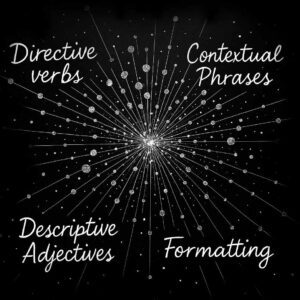Using tone of voice and style descriptions in your prompts is essential if you want your writing to feel unique and stand out. Tone is the emotional or personal attitude behind your words, while style is the way you structure those words—your word choice, sentence length, and overall writing pattern. Being clear about both helps you avoid dull, generic results.
Writing a Descriptive Prompt
When writing a prompt, be sure to include the necessary details when possible, such as the context, the intended scope, audience, tone, and how the text should be organized.
- Context: Are you writing a landing page, fictional story, social media post, or academic paper?
- Scope: Are you focusing on just the introduction, a single section, or the entire piece?
- Organization: Will you structure it chronologically, by topic, or in another way?
- Audience: Who is reading this, and how much do they already know? Are you trying to inform, persuade, entertain, or inspire them?
- Tone: It can be formal, casual, warm, sarcastic, upbeat, critical, humorous, hopeful, etc. Is the language chatty and upbeat, or is it more serious and reserved?
- Style: Word choice (diction), sentence structure (syntax), level of detail, punctuation, and overall linguistic patterns. Short, punchy sentences or long, elaborate ones? Formal or informal?
Add your own perspective and insights or opinions so your text feels fresh and personal. If you need the language model to fill in certain gaps, say so in the prompt. Also consider other factors like pacing, point of view, and amount of detail—all can make your message clearer or more impactful.
After choosing a general tone, you can shape your style by picking specific language (formal or informal, complex or simple) and sentence structure (long and flowing or short and punchy). You can also use figurative language like metaphors, similes, or personification to add flair.
One of the best ways to guide the model is to provide writing samples. Put them in your prompt with clear labels or [brackets] to delimit the text so the AI knows how you want it to sound. You can include something like: “An example of the writing tone and style is delimited between triple quotes: “””THEN PASTE YOUR EXAMPLE WRITING HERE”””.
Tone of Voice Prompt Examples
Below, you will see a variety of tone and style descriptions that can serve as a starting point, whether you want to sound bold and confident, warm and empathetic, or something else entirely. Feel free to mix and match ideas, adjusting them to suit different projects and contexts. Over time, as you experiment and refine your prompts, you’ll develop a signature voice that stands out, and you can revisit or adapt previous instructions to build on your successes.
Playful & Witty
“Adopt a lighthearted, imaginative approach, sprinkling clever wordplay and lively humor throughout. Keep sentences upbeat and energetic, using vivid analogies or pop-culture references to captivate the reader. Don’t be afraid to break conventional rules for comedic effect, but ensure the core message remains clear. The goal is to amuse and delight, leaving your audience with a grin and a sense of connection to your content.”
Warm & Empathetic
“Write with compassion and understanding, speaking gently yet supportively. Use inclusive language (‘we,’ ‘us’) and focus on reassuring the reader that their feelings or experiences are valid. Combine welcoming statements with genuine encouragement, offering guidance without judgment. The overall effect should feel like a comforting conversation with a trusted friend, fostering trust and emotional resonance.”
Inspiring & Uplifting
“Adopt a hopeful, forward-looking tone that motivates readers to believe in their potential. Incorporate vivid language that conjures images of growth and possibility (‘soaring,’ ‘breaking new ground,’ ‘turning dreams into reality’). Use second-person (‘you’) or collective first-person (‘we’) to build a shared sense of purpose. Keep the focus on empowerment and progress, leaving the audience energized and optimistic.”
Minimalist & Crisp
“Communicate with clarity and brevity, stripping away any unnecessary words or ornate phrasing. Organize thoughts logically, using concise sentences and straightforward transitions. The language should be precise and measured, ensuring every word serves a purpose. Aim for a streamlined effect that projects modernity, efficiency, and an uncluttered sense of calm.”
Quirky & Offbeat
“Experiment with imaginative, sometimes unconventional language that surprises and delights. Employ unexpected comparisons, playful exaggerations, and whimsical turns of phrase. Your sentences can vary in length and structure to create a dynamic rhythm that mirrors the tone’s eccentric nature. The goal is to intrigue readers and spark curiosity, delivering a message as striking as it is memorable.”
Sincere & Authentic
“Speak with honesty and vulnerability, using thoughtful, heartfelt language. Write as though you’re talking to a close friend, sharing genuine experiences or insights without embellishment. Acknowledge uncertainties or challenges when relevant, emphasizing genuine intentions over polished façades. This approach fosters trust and emotional connection, as readers sense real human warmth behind the words.”
Straightforward & Pragmatic
“Present information clearly and efficiently, focusing on factual accuracy and practical solutions. Stick to simple sentence structures and direct vocabulary that avoids ambiguity or fluff. Organize ideas in a logical progression, using transitional phrases like ‘first,’ ‘next,’ and ‘finally’ to guide the reader. The result should feel grounded and reliable, offering immediate value and clarity.”
Dark & Poetic
“Infuse the writing with moody, evocative language that stirs the reader’s imagination. Employ a rhythm that is deliberate and sometimes haunting, using metaphors or symbolic imagery to create a sense of depth. While the tone may be somber or intense, it should remain elegant, inviting the reader to explore emotions and shadows in a lush, literary style.”
Sophisticated & Refined
“Adopt a poised, polished voice that subtly conveys expertise. Select words with care, favoring clarity and elegance over ostentation. Use a more formal cadence and sentence structure, incorporating polite transitions or courteous phrases where appropriate. The aim is to exude grace, class, and intellectual depth, creating an impression of cultivated insight.”
Edgy & Provocative
“Write with an unapologetic, boundary-pushing flair that grabs attention. Challenge conventions by posing provocative questions or using confrontational statements. Employ sharp, punchy language and don’t shy away from controversial subjects or bold opinions. The goal is to spark debate, leaving readers buzzing with questions or a fresh perspective—delivered with nerve and conviction.”
Academic & Scholarly
“Craft your prose with intellectual precision and an analytical mindset. Use carefully chosen vocabulary that demonstrates expertise while avoiding unnecessary complexity. Support your points with evidence, references, or citations, and structure your argument logically to guide readers through your reasoning. The result should be informative and credible, reflecting a thoroughly researched and thoughtfully presented perspective.”
Retro & Nostalgic
“Conjure a sense of yesteryear by invoking dated cultural references, vintage expressions, or sentimental imagery. Let your language evoke fond recollections or simpler times, using warm, comforting descriptions and an understated, reflective rhythm. Readers should feel as though they’ve stepped into the past, capturing the charm and wistful allure of bygone days.”
Friendly & Inclusive
“Adopt an inviting tone that greets readers with open arms. Use accessible language and plenty of ‘we’ or ‘us’ statements to foster a collective sense of belonging. Acknowledge different perspectives and experiences, demonstrating empathy and openness. The goal is to make everyone feel welcome and heard, creating a space where all voices matter.”
Informal & Chatty
“Write as though you’re sitting down with a close friend, sharing stories and advice. Keep your language casual, peppering in contractions, slang, or colloquial expressions where natural. Vary sentence length to maintain a conversational rhythm, and don’t be afraid of the occasional playful aside or rhetorical question. The aim is to engage readers in a relaxed, down-to-earth dialogue.”
Mysterious & Suspenseful
“Shroud your narrative in an air of intrigue by hinting at secrets and revelations yet to come. Use atmospheric descriptions and subtle foreshadowing to build tension, employing short, punchy sentences to quicken the pulse at key moments. Carefully reveal details piece by piece, inviting readers to speculate and remain on the edge of their seats. The goal is to keep them guessing and enthralled.”
Motivational & Persuasive
“Galvanize your readers into action with rousing statements and powerful imperatives. Speak directly to their aspirations, framing obstacles as opportunities for growth. Use emotionally charged words and anecdotes to build a sense of urgency or excitement, reinforcing the belief that real transformation is within reach. The tone should instill confidence and a drive to take meaningful steps forward.”
Sentimental & Heartwarming
“Appeal to emotion by weaving heartfelt language and tender, personal anecdotes into your writing. Create a gentle, comforting atmosphere with soft, soothing words and imagery. Focus on universal themes—love, family, belonging—that resonate with readers’ deepest feelings. By the end, they should walk away with a sense of warmth, connection, and well-being.”
Technical & Detailed
“Present information systematically, emphasizing precision and clarity above all else. Use straightforward, factual language, supplemented with charts, data, or examples as needed. Break complex concepts into manageable pieces, guiding readers step by step through the topic. The result should be an authoritative, instructive style that leaves no question unanswered.”
Passionate & Fiery
“Let your words crackle with energy and conviction, leaving no doubt about the depth of your emotion. Use vivid adjectives and dynamic verbs, painting a picture of fervor and intensity. Challenge the status quo or champion a cause with zeal, demanding attention and stirring readers to share your sense of urgency. The tone should be unapologetically bold and driven by deep-rooted passion.”
Reflective & Philosophical
“Encourage contemplation by raising thought-provoking questions and guiding readers through nuanced explorations of big ideas. Emphasize introspection and complexity, using metaphors or analogies that illuminate deeper truths. Maintain a calm, measured pace, allowing each thought to resonate and evolve. The overall effect is introspective, inviting readers to look inward and ponder life’s deeper mysteries.
Futuristic & Visionary
“Embrace forward-looking language that paints a clear picture of what’s next, using imaginative descriptions and bold statements about tomorrow’s possibilities. Employ sleek, innovative terms (‘revolutionize,’ ‘trailblaze,’ ‘reshape’) to show a pioneering spirit. Keep sentences concise yet impactful, suggesting rapid progress and a sense of momentum. The goal is to leave the reader excited about the future and eager to be part of the journey.”
Luxurious & Indulgent
“Use sumptuous language and evocative details that spark the senses, conjuring images of opulence and exclusivity. Let each phrase feel like a gentle caress, filled with rich descriptors (‘velvety,’ ‘sumptuous,’ ‘immaculate’). Maintain a refined cadence, never rushing but rather lingering on key points to highlight premium quality or indulgent experience. The overall effect should be one of elegance, pampering, and heightened desirability.”
High-Energy & Vibrant
“Infuse your writing with a pulse-pounding rhythm and exuberant expressions that burst off the page. Favor active verbs and bright imagery, evoking dynamic visuals (‘blazing trails,’ ‘charging forward,’ ‘buzzing atmosphere’). Keep sentence structure varied and lively, as if the reader is caught up in a thrilling current. By the end, they should feel charged up and swept along by the electrifying tone.”
Artistic & Abstract
“Channel a sense of creativity and wonder, opting for expressive metaphors over literal descriptions. Use poetic language and vivid colors that evoke emotion or spark the imagination (‘fluid kaleidoscope,’ ‘unspoken harmonies’). Vary sentence length to create a flowing, dreamlike rhythm. Readers should feel as if they’re exploring an expansive, imaginative space where interpretations are welcome and boundaries are blurred.”
Urban & Streetwise
“Adopt a voice that’s cool, plugged-in, and a little gritty around the edges. Incorporate modern slang or references to pop culture, but do so with authenticity. Keep the tone confident and savvy, and don’t shy away from direct or punchy lines. The aim is to resonate with a city-smart audience, reflecting the fast pace and constant reinvention of urban life.”
Earthy & Rustic
“Root your writing in nature and tradition, highlighting simplicity and authenticity. Employ down-to-earth language that speaks of sturdy values and hands-on craftsmanship, with words like ‘harvest,’ ‘timeless,’ and ‘weathered.’ Maintain an unhurried, grounded tone, as though you’re inviting readers to slow down and appreciate life’s natural rhythms. The effect should be wholesome, comforting, and deeply connected to the land.”
Graceful & Understated
“Convey refinement through subtlety and restraint, letting elegance shine without grand flourishes. Use carefully chosen words that hint at quality rather than shouting it. Sentences can flow smoothly into one another, ensuring a polished cadence that never feels forced. The goal is to exude quiet confidence and sophistication, drawing readers in with soft-spoken finesse.”
Nurturing & Gentle
“Write as if cradling the reader in a warm, supportive environment, using kind language that offers reassurance and care. Favor soothing imagery (‘soft lullabies,’ ‘steady guiding hand’) and gently encourage the audience to explore new thoughts or actions. Keep the pace calm and unhurried, ensuring the reader feels safe and validated. By the end, they should feel comforted and uplifted.”
Calm & Meditative
“Adopt a serene, introspective tone that invites the reader to slow down and reflect. Use contemplative language (‘mindful awareness,’ ‘inner stillness’) and gentle pacing, with smooth transitions that encourage a steady flow of ideas. Focus on centering the audience, helping them find clarity and peace in your words. The result should be a tranquil, almost therapeutic reading experience.”
Full Prompt Examples
For the best results when working with an LLM, crafting detailed prompts that include clear tone of voice and style instructions can make all the difference. Below, you’ll find a collection of example prompts designed to produce richer, more dynamic outputs than generic requests. Each one demonstrates how specifying tone and style can transform the final result.
Bold & Confident Landing Page Copy for a Home Service Company
Write a high-converting landing page for a plumbing company that specializes in residential and commercial services, including emergency repairs, leak detection, drain cleaning, and full plumbing installations. The page should instantly capture attention, establish authority, and drive action—whether that’s calling for service, requesting a quote, or booking an appointment. Make it direct, results-driven, and persuasive. Avoid unnecessary fluff and focus on credibility, urgency, and trust to convert visitors into customers fast.
Use a Bold & Confident tone throughout. Every sentence should exude expertise, reliability, and strength, leaving no room for doubt. No weak qualifiers—just direct, powerful statements that reinforce why this company is the go-to choice for fast, professional, and high-quality plumbing services. The voice is assertive, straightforward, and self-assured, often using short, direct sentences and commanding verbs such as “Own it” or “Take charge.” Think strong action verbs, assertive phrasing, and compelling language that instills trust.
The structure should be clean, concise, and easy to skim. Open with a hard-hitting, benefit-driven headline, followed by a short yet engaging introduction that highlights experience, fast response times, and unbeatable service quality. Service offerings should be listed in scannable sections with bold subheadings, emphasizing benefits over features. Reinforce trust factors like licensing, guarantees, same-day service, and years of expertise. Wrap up with a strong, no-nonsense call-to-action that makes it clear: the best plumbers are just a call away.
Quirky & Offbeat LinkedIn Biography for a Real Estate Agent:
“Write a LinkedIn bio for a Realtor who specializes in helping first-time homebuyers. Assume the reader is a prospective client or a professional connection who may know very little about the realtor. Your goal is to capture attention, inform them about the realtor’s strengths, and keep the tone personable yet professional enough for LinkedIn.
Use a Quirky & Offbeat tone/style throughout. That means your writing should be a bit eccentric, creative, and playful—think unexpected metaphors, humor, or whimsical turns of phrase. Vary sentence length to maintain a lively rhythm, and don’t be afraid to use imaginative comparisons. The overall style should feel casual and friendly, but clearly communicate the realtor’s expertise and enthusiasm for helping clients.
Keep the content organized by lightly introducing the realtor’s background, unique qualities, and approach to real estate, but don’t structure it chronologically; let the fun personality and professional points intertwine in a natural, upbeat flow.
You can include a playful sign-off or catchphrase that underscores the realtor’s personality. The bio should be concise (around 100–150 words) so it’s effective on LinkedIn and easy to read. Include relevant details like areas of specialization (e.g., first-time homebuyers, particular neighborhoods), personal touches (like hobbies or a fun fact), and any notable achievements. Keep it short, sweet, and slightly off-the-wall to grab attention. Avoid being too formal or reserved—lean into the quirky and unique aspects that make this realtor stand out.”
Straightforward & Pragmatic About Page Copy for a Financial Services Company
“Write an About Page for a financial services company that provides investment advice, wealth management, and retirement planning. The target audience includes potential clients, partners, and anyone exploring the company’s services for the first time. Readers may know little to nothing about this brand, so clarity and trustworthiness should be priorities.
Use a Straightforward & Pragmatic tone/style. This means focusing on clarity, efficiency, and directness in both language and structure. Favor concise sentences that present facts and services plainly, avoiding unnecessary jargon or marketing fluff. Keep the wording professional yet accessible: introduce the company’s history, mission, and key services in a logical flow—most likely starting with a brief background, then explaining core services and unique differentiators, and finally discussing the team or values.
Highlight strengths such as the team’s expertise, the value of transparent communication, and how the company supports its clients in achieving financial goals. Avoid flowery language or overly promotional claims; instead, stick to data-driven or evidence-based statements where possible. Provide a tangible sense of how the company operates and why clients can trust them. End with a clear statement inviting readers to learn more or get in touch, ensuring the entire About Page feels both informative and approachable.”
Luxurious & Indulgent Product Description for a Beauty Brand
“I want you to write a product description for a high-end lip gloss from a luxury beauty brand. The description will be used on a product landing page, designed to captivate and persuade potential customers. It should highlight the product’s unique features, such as its texture, finish, key ingredients, scent, long-lasting formula, or nourishing benefits. This lip gloss is a premium offering, designed for beauty lovers who appreciate elegance, self-care, and indulgence.
Use a Luxurious & Indulgent tone/style. The language should be rich, sensual, and evocative, immersing the reader in a world of beauty and elegance. Word choice should be sumptuous and descriptive, using terms like ‘silken,’ ‘radiant,’ ‘irresistible sheen,’ and ‘luminous glaze’ to evoke texture and experience. Sentences should flow smoothly, creating a sense of indulgence and desire. Incorporate sensory details, describing how the gloss glides effortlessly, leaves a soft kiss of color, or imparts a delicate, enchanting fragrance. Avoid bland or overly technical descriptions—every phrase should add to the feeling of luxury.
Organize the copy in a way that first captures attention, then highlights the key benefits, and finally reinforces why this is a must-have for those who desire a sophisticated beauty experience. Keep the format concise yet captivating, ensuring that every word feels intentional. The result should be an irresistible, poetic description that makes the reader feel as though they are indulging in a glamorous beauty ritual, not just purchasing a lip gloss. End with an enticing call to action, encouraging the reader to experience this luxurious formula for themselves.”
Experiment, Refine and Adapt
Finding the perfect tone of voice and style for your prompts is both an art and a science. While the examples provided can serve as a strong starting point, the real magic happens when you experiment, refine, and adapt your instructions to fit your unique needs. Every brand, writer, and project is different, and the more you customize your prompts, the more tailored and impactful your AI-generated content will become. The key is to be specific, test variations, and refine based on the results—there’s no single perfect formula, and the field of prompt engineering is still evolving with ongoing research.
To dig deeper into crafting your own tone of voice, explore our list of tone of voice words, which provides a collection of adjectives and descriptions to help you articulate the exact tone you want. Additionally, our article on well-known brand voices will give you a deeper understanding of how some of the world’s most successful companies shape their messaging. Understanding these distinct brand identities can inspire you to refine your own voice and develop more compelling prompts.
We also have tools to help you analyze and refine your writing style. Our Brand Voice Analyzer allows you to paste your copy and receive a detailed tone and style description, along with a custom prompt to help you recreate and maintain consistency in your writing. Whether you’re crafting marketing copy, social media content, or professional communications, this tool can guide you toward more effective AI-generated text.
While many of the prompts shared here will yield strong results, experimentation remains key. The best approach is to test different variations, analyze what works, and continuously refine your strategy. Prompt engineering is a rapidly evolving space, and by staying curious and adaptable, you’ll be at the forefront of creating content that is both compelling and uniquely yours. Keep exploring, refining, and shaping your brand’s voice—your next breakthrough prompt could be just one experiment away.








